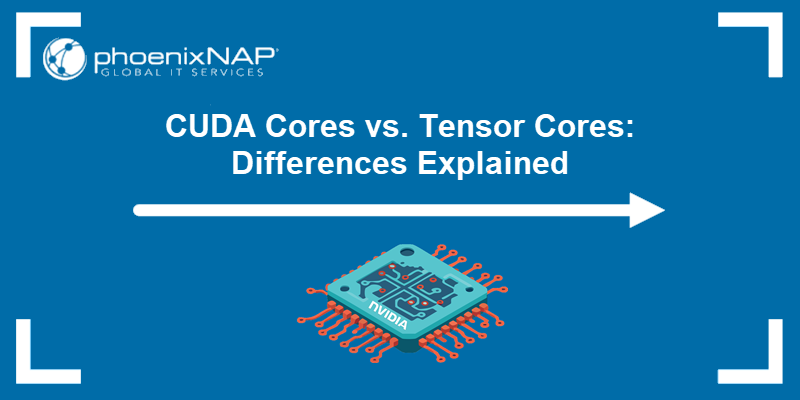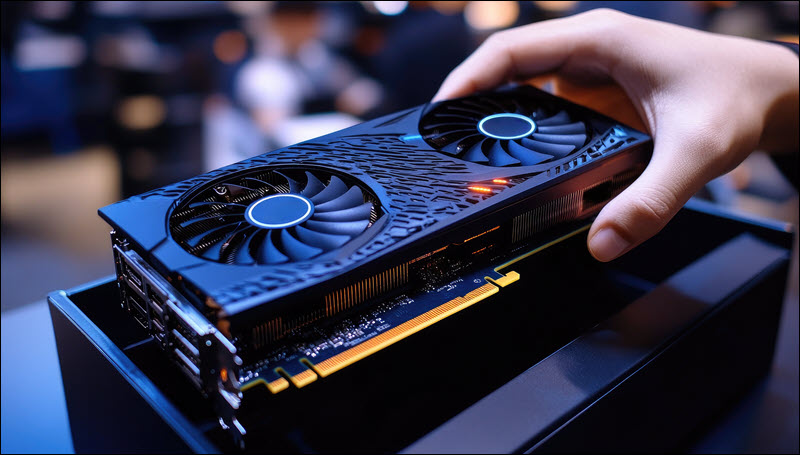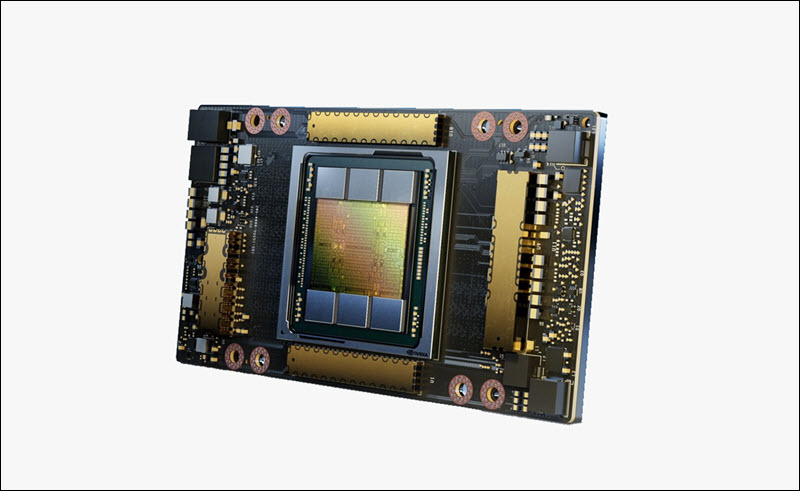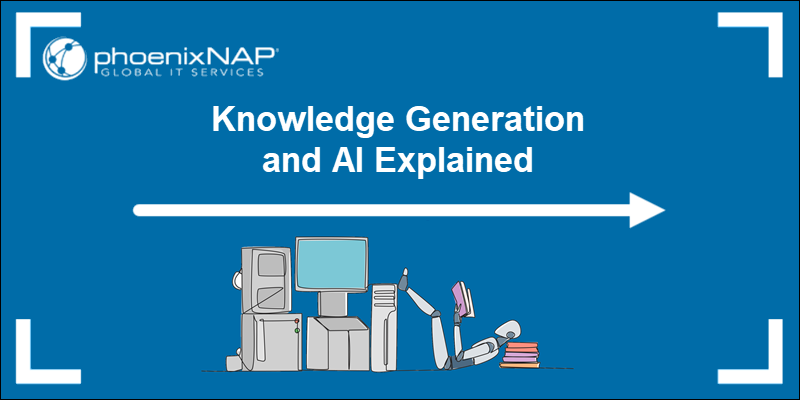For a long time, GPUs were synonymous with gaming. However, their role has expanded, and today they power everything from large language models (LLMs) to self-driving cars.
In 2006, NVIDIA introduced the CUDA programming model, which enabled its GPUs with CUDA cores to function as general-purpose computing devices.
Tensor Cores were a later addition (2017) designed to accelerate matrix operations that dominate AI and deep learning. Together, CUDA and Tensor Cores form the foundation of NVIDIA's modern GPU lineup.
Discover the differences between CUDA cores vs. Tensor cores and which workloads benefit most from each core type.

What Is a CUDA Core?
A CUDA core is a lightweight execution unit inside an NVIDIA GPU. Each core processes a single thread and performs basic arithmetic operations, such as addition and multiplication, as well as logic operations like comparisons.
An NVIDIA GPU contains thousands of CUDA cores and can execute massive numbers of threads at the same time. The cores are simple and efficient, relying on other specialized GPU components for caching and memory management.
This architecture makes CUDA cores ideal for workloads that can be parallelized, such as deep learning training and inference, real-time graphics rendering, and large-scale scientific simulations.
Note: See our full list of the best GPUs for training and inference workloads.
How Does a CUDA Core Work?
CUDA cores operate under the CUDA programming model. This architecture enables maximum throughput through the following steps:
- Developers break down computational problems into many small, independent tasks called threads.
- Up to 32 threads are grouped into warps. A warp is a basic scheduling unit in an NVIDIA GPU.
- The GPU's hardware scheduler assigns warps across the available CUDA cores. This action by the scheduler often spans thousands of cores simultaneously.
- Each core executes the same instruction on its assigned thread. These are usually simple arithmetic or logic operations.
- If one warp is waiting on data from memory, the scheduler switches the tasks to another warp to speed up processing and reduce the number of idle cores at any given time.
- Since there are thousands of active warps and cores, the GPU can run tens of thousands of threads simultaneously, a technique known as multithreading.
- When all threads finish their tasks, the system combines the results into a final output. The output can be a rendered image, a trained neural network layer, or a physics simulation step.
This design allows CUDA cores to complete thousands of simple tasks concurrently, rather than a single complex task sequentially, as a CPU does.

CUDA Core Practical Applications
CUDA cores and the CUDA programming model are used across a wide range of industries, such as:
- Graphics and gaming. CUDA core GPUs can process millions of pixels and vertices in parallel. As a result, 3D scenes and visual effects render in real-time, frame rates per second are higher, and gameplay is smoother.
- AI and machine learning. Before Tensor Cores were introduced, CUDA cores were used for training and inference for neural networks. They are still relevant for handling logic, preparing data, controlling flows in AI pipelines, and for other tasks outside matrix math.
- Scientific research. Physics, chemistry, and biology simulations rely on CUDA acceleration to process large datasets in various research fields. Applications include genomic sequencing, rapid cancer diagnostics, and molecular modeling.
- Financial assessments and analysis. CUDA accelerates risk assessment, fraud detection, and pricing simulations. Using CPUs for these tasks would significantly increase compute time and costs in an industry where rapid response and ROI are critical.
- High-Performance Computing (HPC). CUDA cores contribute to supercomputing workloads. They power weather forecasting, aerospace design, automotive engineering, and large-scale climate simulations.
Note: Find out how HPC and AI are rapidly transforming the enterprise and scientific computing landscape.
CUDA Core Advantages
CUDA cores are fundamental to NVIDIA GPUs because they provide:
- Massive parallelism. Thousands of cores can execute tasks concurrently, making GPUs far more efficient than CPUs for large-scale parallel workloads.
- A versatile programming model. Developers can use the CUDA programming model to program GPUs for general-purpose computing and extend their role into fields beyond graphics, such as machine learning, finance, and emerging HPC applications.
- Scalability. The same CUDA architecture scales from consumer GPUs for personal gaming to data center accelerators and even supercomputers.
- A mature ecosystem. CUDA is well tested in real-life scenarios and is backed by a mature software ecosystem and extensive libraries. It has strong community support, making it easier to build and deploy GPU-accelerated apps.
Note: Explore examples of industries most impacted by AI.
CUDA Core Disadvantages
Some of the limitations of CUDA cores include:
- Not suited for serial tasks. CUDA cores underperform compared to CPUs for single-threaded or sequential workloads.
- Programming complexity. Writing and optimizing CUDA cores requires specialized knowledge and careful attention to memory usage and thread synchronization. Developers often need to invest significant time and effort to achieve peak performance.
- Vendor lock-in. CUDA is proprietary to NVIDIA. It means that you may encounter compatibility issues with competing hardware, such as AMD ROCm or Intel oneAPI.
- High power consumption. GPUs are efficient in terms of operations per watt, but their absolute power consumption is very high.
Note: Running thousands of GPU cores generates enormous heat. Find out how data centers handle cooling.
What Is a Tensor Core?
A Tensor Core is a specialized execution unit inside an NVIDIA GPU. It complements CUDA cores and optimizes NVIDIA GPUs for AI environments and HPC workloads.
Tensor Cores were developed specifically to accelerate matrix math operations. These types of operations are essential for deep learning training, inference, and scientific applications.
If a Tensor Core is present in an NVIDIA GPU, the GPU scheduler automatically routes matrix math workloads to Tensor Cores instead of CUDA cores.
Note: A Tensor Core is NVIDIA's proprietary technology. If you are looking for information on Google's Tensor Processing Unit (TPU), see our separate article comparing TPUs and GPUs.
How Does a Tensor Core Work?
Tensor Cores accelerate matrix multiply-and-accumulate (MMA) operations through the following steps:
- The GPU detects workloads that involve matrix math, and its scheduler routes these operations to Tensor Cores instead of general-purpose CUDA cores.
- Large matrices consist of smaller sections, called tiles. Each Tensor Core processes one tile at a time. Dozens or hundreds of Tensor Cores work simultaneously, each handling its own assigned matrix tile. This property allows billions of multiply-accumulate operations per second.
- Within each tile, Tensor Cores multiply the elements from two input matrices. The cores perform multiplications in lower-precision formats, such as FP16, BF16, INT8, and FP8, which are faster and use less memory.
- Once all Tensor Cores finish their assigned tiles, the system sums (accumulates) results into an output matrix using the high-precision FP32 format to preserve data accuracy.
- In deep learning, this process repeats layer after layer across millions or billions of operations.

Tensor Core Practical Applications
Tensor Cores are used exclusively for workloads that depend on fast linear algebra and dense matrix operations, such as:
- Large Language Models (LLMs). Training and inference for large language models like GPT and BERT.
- Computer vision. Applications like Image recognition, object detection, medical imaging, and self-driving cars.
- Speech and natural language processing (NLP). Voice assistants, real-time translation, and transcription models.
- Recommendation systems. Used for real-time recommendation and ranking algorithms utilized in e-commerce and social platforms.
- HPC. Scientific workloads, like molecular dynamics, quantum chemistry, and climate models that can be expressed as dense matrix operations.
Note: LPUs are a new class of processors, designed specifically for large language models (LLMs). Find out how GPUs and LPUs differ.
Tensor Core Advantages
Tensor Cores are indispensable because they:
- Accelerate AI training and inference. Tensor Cores deliver massive throughput for matrix operations. The values are often several times higher than standard CUDA cores.
- Support mixed-precision data arithmetic. Tensor Cores use lower precision formats like FP16, FP8, and INT8 for multiplication, and the FP32 high precision format to accumulate results. This mixed-precision method maximizes performance without a significant loss of model accuracy.
- Improve energy efficiency. Compared to CUDA cores, Tensor Cores can finish training and inference much faster, resulting in less power consumption and lower computing requirements.
- Integrate seamlessly with AI frameworks. Deep learning libraries such as cuDNN and TensorRT automatically use Tensor Cores without requiring developers to write low-level code.
Note: Check out the top 14 machine learning libraries developers use to build and deploy ML models.
Tensor Core Disadvantages
The limitations of Tensor Cores include:
- Specialized use. They accelerate matrix-math but are not efficient in general-purpose instructions. They function only alongside CUDA cores.
- Precision limitations. They are very fast but must sacrifice precision in return. This is acceptable for most AI tasks, but not for workloads that require full numerical precision, like financial modeling.
- Limited availability. Only available in newer (Volta or later) NVIDIA GPUs.
- Vendor lock-in. Like CUDA cores, Tensor Cores are tied to the NVIDIA ecosystem. Software optimized for Tensor Cores may not run efficiently on hardware from other vendors.
Note: Find out what the 13 best AI processors on the market offer in terms of features and capabilities.
CUDA Cores Vs. Tensor Cores: Differences
The following table highlights the main differences between CUDA vs. Tensor Cores:
| Feature | CUDA Cores | Tensor Cores |
|---|---|---|
| First Introduced | 2006 (alongside CUDA programming model) | 2017 (Volta architecture, Tesla V100) |
| Purpose | General-purpose execution units in all NVIDIA GPUs. | Specialized units for matrix multiply-and-accumulate (MMA) operations. |
| Workload Optimization | Graphics rendering and general-purpose computing (GPGPU). | Deep learning, LLMs, AI training and inference, dense matrix workloads. |
| Availability | Present in all NVIDIA GPUs. | Present only in GPUs from Volta (2017) onward, mainly RTX and data center GPUs. |
| Dependency | Can operate independently for all workloads. | Depends on CUDA cores for non-matrix instructions and scheduling. |
| Precision Support | FP32, FP64 (on some GPUs), INT | Mixed precision: Low-precision FP16, BF16, INT8, and FP8 for multiplication. High-precision FP32 for accumulation. |
| Parallelism Style | Executes thousands of threads. Single Instruction, Multiple Threads (SIMT). | Processes entire matrix tiles (e.g., 4×4, 8×8, 16×16) per clock cycle. |
| Programming Model | CUDA C/C++, OpenCL, DirectCompute, etc. | Accessed via NVIDIA libraries and frameworks. |
| Use in Gaming | Essential for graphics and real-time rendering in games. | Not used in traditional graphics rendering. |
| Use in AI and ML | Can run AI workloads, but much slower than Tensor Cores. | Specifically designed to accelerate AI and ML computations. |
| Energy Efficiency | Higher power draw for AI tasks compared to Tensor Cores. | More efficient for AI workloads (fewer watts per operation). |
Purpose
NVIDIA introduced CUDA cores to accelerate the rendering of complex 3D environments, revolutionizing CGI and animation in gaming, movies, and the entertainment industry. Due to their parallelism and the CUDA programming model, they were later adopted for general-purpose GPU computing (GPGPU) across a wide range of industries.
Tensor Cores address a new demand: AI and machine learning. NVIDIA designed them specifically and only for matrix math. Their purpose is to accelerate dense linear algebra operations in HPC and deep learning.
Precision
CUDA cores support FP32, FP64, and INT data formats. They are essential in applications where numerical accuracy is critical, such as financial modeling, engineering, or scientific simulations. For example, an NVIDIA A100 GPU can deliver up to 20 TFLOPS of FP32 performance from its CUDA cores.
Tensor Cores apply mixed-precision arithmetic to both increase throughput and preserve accuracy. The cores perform multiplications in lower-precision formats like FP16, INT8, BF16, and FP8, but the results are accumulated in the high-precision FP32 format. On the same A100 GPU, Tensor Cores can deliver up to 312 TFLOPS in FP16. This is a 16x throughput increase over CUDA cores for matrix math.
Note: Are you thinking of starting a machine learning project? Check out these 30 machine learning project ideas for all levels.
Execution Model
CUDA cores follow the CUDA programming model, where threads (usually 32) are grouped into warps. Each CUDA core executes one thread at a time. High throughput is achieved by scaling execution across thousands of parallel warps.
Tensor Cores operate on matrix tiles instead of individual threads. A single core can perform hundreds of fused multiply-and-accumulate (MMA) operations on a 16x16 block of data per cycle. The tile-based parallelism explains why they achieve throughput orders of magnitude beyond CUDA cores for linear algebra tasks.
Developer Access
CUDA cores are programmed explicitly through CUDA C/C++, OpenCL, or DirectCompute. Developers need to micromanage threads, memory, and synchronization. This provides flexibility but also adds several layers of complexity to the programming process.
Tensor Cores are accessed indirectly through NVIDIA's optimized libraries like cuDNN and TensorRT, and through deep learning frameworks, such as PyTorch and TensorFlow. These tools automatically route eligible matrix operations to Tensor Cores. Developers do not need to write low-level Tensor instructions.
Note: Find out which 10 AI programming languages should be at the top of your learning list and what makes them an excellent choice for AI projects.
Energy Efficiency
CUDA cores can execute thousands of lightweight threads in parallel and achieve higher throughput per watt. They are more efficient than CPUs for parallel workloads.
Tensor Cores push efficiency even further by combining matrix multiplications and accumulations into a single hardware instruction. They also exploit mixed precision to reduce memory traffic, a major source of GPU power consumption. Tensor Cores can deliver 15 to 20 times more floating-point operations per watt for AI workloads than CUDA cores alone.
Throughput-per-watt efficiency is the reason why AI training at scale is not practical without Tensor Cores.
Ecosystem Support
CUDA is a mature ecosystem that has been thoroughly tested and refined over the past two decades. It boasts a large developer community and a wide range of resources.
Tensor Cores are used through NVIDIA's own AI libraries and frameworks. Developer access is straightforward, but performance depends on NVIDIA's ecosystem. This can limit portability to competing platforms, like AMD or Intel.
Note: Before you can use CUDA or Tensor Cores, you must install the right drivers. Find out how to install NVIDIA drivers on Ubuntu or install NVIDIA drivers on Debian.
Hardware Availability
CUDA cores are available in every NVIDIA GPU, from GeForce gaming cards to professional Quadro, Tesla, and modern RTX/Hopper GPUs.
Tensor Cores are present only in GPUs from Volta (2017) onward. They are found in RTX consumer GPUs and in data center GPUs, such as the A100 and H100. For example, an RTX 4090 features 16,384 CUDA cores and 576 Tensor Cores.
Flexibility
CUDA cores are flexible and can execute any kind of instruction. This makes them indispensable for workloads that involve irregular memory access, branching logic, or non-matrix computations.
Tensor Cores are designed for specialized workloads. They accelerate matrix operations but cannot run general-purpose instructions. They rely on CUDA cores to handle orchestration and all non-matrix tasks.
Note: The number of companies adopting AI in their operations is rising rapidly. To implement it responsibly, learn more about AI regulatory and ethical concerns.
CUDA Cores vs. Tensor Cores: How to Choose?
All NVIDIA GPUs include CUDA cores, which are always active by default. When Tensor Cores are also present, the GPU is optimized for AI and large language model (LLM) workloads.
Choose CUDA cores if you need:
- General-purpose parallel computing.
- Mixed workloads that are not purely matrix math.
- Broad compatibility, as every NVIDIA GPU has CUDA.
- Traditional use cases include gaming, finance, and professional design and engineering applications.
Use Tensor Cores alongside CUDA if you are running:
- AI-heavy workloads like LLMs, CNNs, RNNs, or transformers.
- Matrix-dominated tasks like speech recognition, recommendation systems, or linear algebra.
- Mixed-precision training and inference, where full precision is not required.
- Modern NVIDIA GPUs with AI libraries that automatically offload eligible operations to Tensor Cores.
In practice, Tensor Cores do not replace CUDA cores; they complement them. Every real workload uses both. CUDA handles general compute tasks, and Tensor Cores accelerate matrix-intensive operations.
Conclusion
The differences between CUDA vs. Tensor Cores are now clear. Together, they make NVIDIA's GPUs versatile enough to power everything from gaming to large-scale AI training.
If you are considering deploying these technologies at scale, explore neocloud providers that offer GPU-as-a-Service (GPUaaS) to reduce upfront costs.
